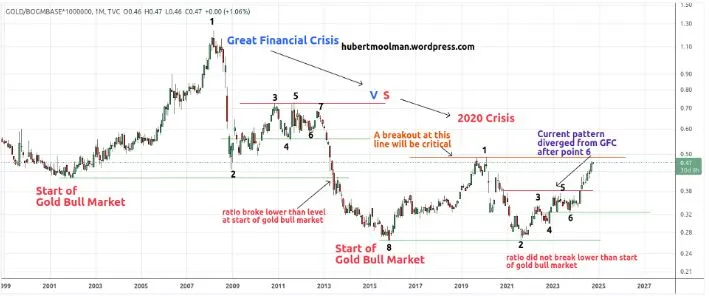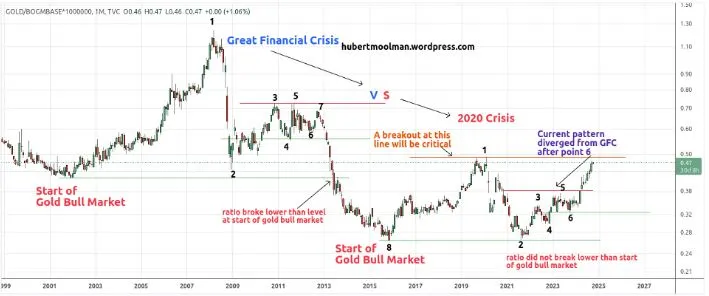Fiat money, once the foundation of modern economies, faces unprecedented challenges in 2024. As the global financial system shows increasing signs of strain, more experts are questioning whether fiat money can continue to hold its value. Fiat money, which derives its worth from government backing rather than physical commodities, has long been the engine driving economies worldwide. However, recent developments indicate that this system may be faltering, leading many to consider whether we are witnessing the beginning of its end.
The most significant warning sign is the rapid rise of the gold bull market and the consistent U.S. dollar debasement. With inflation soaring, interest rates climbing, and gold breaking out of its historical containment, faith in fiat currencies, especially the U.S. dollar, is waning. Throughout history, fiat systems have struggled when confidence is lost, and current trends show that trust in the U.S. dollar is slipping at a dangerous rate.
The Fragility of Fiat Money in a Changing Economy
Fiat money, by design, relies entirely on trust. Unlike gold or other commodities, fiat currencies hold no intrinsic value. Their worth is purely symbolic, determined by the policies of central banks and governments. However, this reliance on trust makes fiat money vulnerable to economic shocks. During the 2008 financial crisis, massive interventions in the form of quantitative easing saved the system, but at what cost? The global monetary base expanded rapidly, and the U.S. dollar debasement accelerated.
By 2020, another crisis emerged. In response to the COVID-19 pandemic, central banks once again flooded the market with newly created currency. The monetary base surged, but unlike in 2008, the system is now showing deeper cracks. This time, the debasement of the U.S. dollar appears more pronounced. Fiat currencies around the world are under pressure as inflation climbs and the velocity of money slows. The global financial system is standing on precarious ground.
Gold’s Rise Signals a Shift Away from Fiat Money
Historically, when fiat currencies falter, gold becomes the preferred store of value. This has been evident in 2024, where gold prices have surged, creating what many are calling the next gold bull market. In the late 1970s, gold prices spiked as confidence in the U.S. dollar crumbled. Central banks had to intervene with massive interest rate hikes to restore faith in the monetary system.
Today, gold is rising for similar reasons. Investors are fleeing fiat currencies, particularly the U.S. dollar, in search of stability. This shift is more than just a reaction to inflation. It reflects a growing loss of confidence in the ability of central banks to control the situation. As gold breaks through previous resistance levels, it suggests that the demand for physical assets is growing, signaling that the financial landscape is shifting.
While fiat money can be printed at will, gold remains a finite resource. This limitation is what makes it so attractive in times of crisis. With central banks continuing to expand the monetary base, many investors see gold as the ultimate hedge against U.S. dollar debasement. Every time the U.S. government prints more money to stimulate the economy, it further dilutes the value of existing dollars, pushing more people toward gold.

The Velocity of Money and Fiat Currency Decline
A key indicator of economic health is the velocity of money, which measures how quickly currency circulates in the economy. A low velocity indicates that people are holding onto their money rather than spending it, which typically signals a lack of confidence in the future. During the 2008 financial crisis, the velocity of money dropped sharply, and central banks responded by expanding the monetary base to inject liquidity into the system.
However, the effects of these interventions appear to be diminishing. Since 2020, the velocity of money has plummeted once again, despite massive increases in the monetary base. This suggests that the underlying problem has not been solved. Rather, it has been postponed by continuous injections of liquidity. As long as fiat money continues to lose value through debasement, people will hesitate to spend, hoarding their currency in fear of further economic instability.
This creates a dangerous cycle. The more the velocity of money drops, the more central banks will feel compelled to print money, further debasing the currency. This is a stark reminder of the inherent weakness of fiat money systems. They depend on perpetual confidence and liquidity, both of which are eroding quickly.
Central Bank Policies: Solutions or Temporary Fixes?
Central banks around the world, especially the Federal Reserve, have employed various tools to maintain the stability of fiat money. Lowering interest rates, quantitative easing, and stimulus packages have become the go-to remedies during times of crisis. While these policies provided temporary relief during the 2008 crisis, their repeated use is now contributing to the systemic fragility of the global financial system.
For example, in response to the 2020 economic collapse, central banks injected trillions of dollars into the economy, significantly expanding the monetary base. Initially, this solved the liquidity problem, but the long-term consequences are becoming clear. The continuous printing of money has led to U.S. dollar debasement, making each dollar less valuable over time.
This has created a situation where the system is constantly chasing its own tail. Every new injection of money solves the immediate problem but weakens the currency further. This, in turn, requires even larger interventions the next time a crisis arises. Many experts are now questioning whether the fiat money system can survive another major shock. If confidence collapses entirely, fiat money may be doomed to fail.
The Road Ahead: Can Fiat Money Survive?
The future of fiat money depends on several factors. The most important of these is whether central banks can restore confidence in their currencies. If inflation continues to rise and interest rates remain low, the trust in fiat currencies like the U.S. dollar will likely erode further. Without confidence, fiat money cannot function effectively.
Another factor is the continued rise of gold. If the gold bull market continues, it will further signal a loss of confidence in fiat currencies. In 2024, gold’s breakout to new highs is not just a reflection of inflation fears but also a statement about the weakening role of fiat money in the global economy.
The rise of alternative currencies, such as cryptocurrencies, also plays a significant role. These new forms of money challenge the dominance of fiat systems by offering decentralized and limited-supply alternatives. While gold remains the ultimate safe-haven asset, the increasing popularity of digital currencies further complicates the future of fiat money.
Conclusion: A Shifting Financial Landscape
The signs of a shifting economic landscape are becoming impossible to ignore. Fiat money, particularly the U.S. dollar, is facing an existential crisis. The rise of the gold bull market, combined with the continuous U.S. dollar debasement, paints a worrying picture for the future of fiat currencies. The monetary base continues to expand, but this only exacerbates the problem rather than solving it.
As the velocity of money continues to decline, it reflects a deeper lack of confidence in the system. Central banks have been able to stave off collapse thus far, but for how long? The financial crisis of 2008 provided a temporary reprieve, but the underlying issues have not gone away. Instead, they have worsened.
Ultimately, the end of fiat money may not happen overnight, but the signs are there. The global financial system is more fragile than ever, and confidence in fiat currencies is dwindling. Whether through gold or alternative currencies, the future may look very different from the fiat-dominated system of today. The question is no longer if fiat money will fail, but when.
Click here to read our latest article Gold Price Surge Signals Demand




